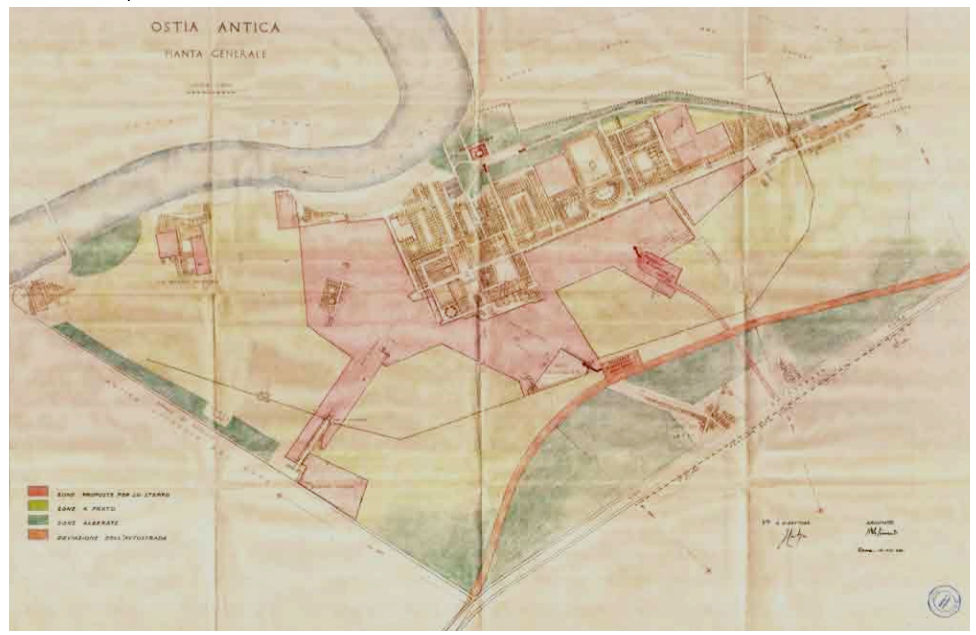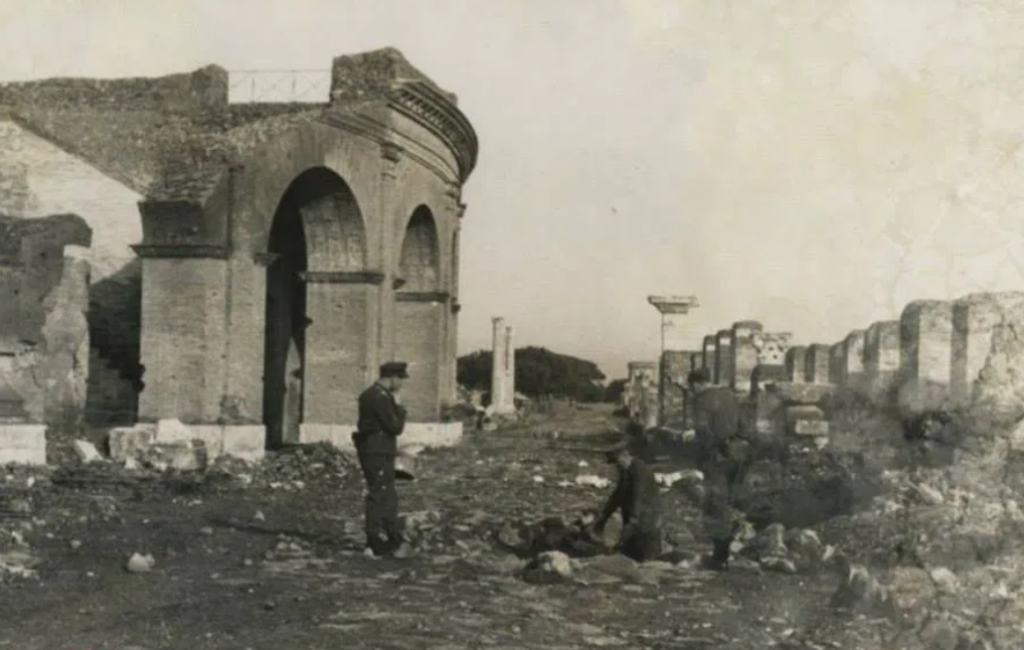THE EXCAVATIONS FOR THE WORLD EXHIBITION IN ROME: 1938 - 1945
About two-thirds of the ruins of Ostia that can be seen today were excavated in the years 1938-1942. The initiator was Mussolini, who wanted to present Ostia during a World Fair in Rome, the Esposizione Universale di Roma (EUR). Due to the war, it would not take place.

Plan of Ostia with a colour-coded indication of the dates of the excavations.
Blue: pre-20th century; yellow: 1900-1937; red: 1938-1942.
The colour coding was done by Michael Heinzelmann.

A plan of Ostia from 1937. In pink the areas earmarked for excavation.
Rinaldi 2012, fig. 1.
The work was led by Guido Calza. It did not differ much from the earlier papal excavations. More than 600.000 cubic meters of earth were removed, that had reached a height of 4 to 12 metres above the ancient street level. Some 150 labourers worked, basically, with the equipment from the early twentieth century. Needless to say that much information was not recorded during these five years. For example, the excavation and restoration of the Baths of the Seven Sages (III,X,2) and the adjacent House of Serapis (III,X,3), between 1935 and 1940, is documented almost exclusively through many photos. The Giornale degli Scavi lists the major finds, with a rough indication of the place of discovery. The photos of the excavations illustrate the tremendous effort that was needed to clear, preserve and restore the ruins. But much information was lost. Slow and accurate excavations would have provided precious evidence, especially about the city in the third and fourth century.

Guido Calza (third from the left) in 1938. Photo: Parco Archeologico di Ostia.

The excavations of the Baths of the Seven Sages. Photo: Archivio Fotografico Ostia, neg. B 2525.

The excavations of the Baths of the Seven Sages. Photo: Archivio Fotografico Ostia, neg. B 2558.

The excavations of the Baths of the Seven Sages. Photo: Archivio Fotografico Ostia, neg. B 2569.

The excavations of the Baths of the Seven Sages. Photo: Archivio Fotografico Ostia, neg. B 2571.

The excavations of the Baths of the Seven Sages. Photo: Archivio Fotografico Ostia, neg. B 2579.

The excavations of the courtyard of the House of Serapis.
Photo: Archivio Fotografico Ostia, neg. B 2527.

The excavations of the courtyard of the House of Serapis.
Photo: Archivio Fotografico Ostia, neg. B 2547.

The courtyard as it appears today. Photo: Klaus Heese.
In June 1940 many works of art were protected, out of fear for air raids. In 1943 the area was evacuated, because an allied landing was feared (which would take place in Anzio in 1944). In January 1944, one bomb was dropped accidentally on Ostia Antica by the allied forces. It landed near the theatre, but did not explode. The museum was closed. It was reopened on June 12 1945 (see the press statement of the Allied Forces).

Statues protected by sandbags in 1940. Photo: Parco Archeologico di Ostia.

A bunker near the museum. Here objects from the museum were stored during WW II.
Photo: Jan Theo Bakker.

German soldiers inspecting the bomb that landed near the theatre.